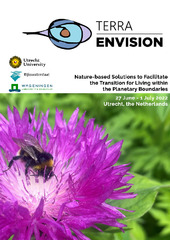Приказ основних података о документу
Increase of Sustainability of Urban Forests by Prevention of Land Degradation
| dc.creator | Kašanin-Grubin, Milica | |
| dc.creator | Živanović, Nikola | |
| dc.creator | Ferreira, Carla | |
| dc.creator | Rončević, Vukašin | |
| dc.creator | Veselinović, Gorica | |
| dc.creator | Antić, Nevena | |
| dc.creator | Štrbac, Snežana | |
| dc.date.accessioned | 2023-08-29T20:23:46Z | |
| dc.date.available | 2023-08-29T20:23:46Z | |
| dc.date.issued | 2022 | |
| dc.identifier.uri | https://cer.ihtm.bg.ac.rs/handle/123456789/6533 | |
| dc.description.abstract | An urban forest includes trees and shrubs, but these vegetative structures can be also found in parks, gardens and along streets within urban areas. In many regions, urban forests are the most extensive, functional, and visible form of green infrastructure in cities and have an important place in the combat against climate change, preservation of forest ecosystems. Urban forests are safe islands for biodiversity and play a key role in preserving human health and raising the quality of life in the city. The Kosutnjak urban forest, Belgrade, Serbia, occupies a total area of 305.32 ha, from which 83% is forested. Altitude varies in the range of 75 to 217 m above sea level and the climate is temperate-continental. In 2014, 93% of the area was declared a Monument of Nature "Kosutnjak Forest” while the remaining 7% of the forest is intended for recreation and general cultural and educational functions. The coniferous natural hardwood covers almost 70% of the total area. Generally, trees are characterized by poorly developed canopy, often rotten. The forest was seriously affected by the snowfall in December 2021. A large number of trees fell, broke and bent. The general condition of the forest is unfavorable, the assembly is interrupted and damaged. Due to steep slopes and generally poor condition of vegetation on the entire surface of the Kosutnjak forest, erosion processes are observed in the form of leaching, furrows, ravines and local movements of soil masses. Other forms of physical land degradation are compaction associated with occurrence of tracks. The aim of this study is to determine the connection between the productivity of forest ecosystems and soil quality. Soil physical- chemical characteristics contribute to determining the sensitivity of the soil of the Kosutnjak urban forest to degradation processes and the connection between the state of vegetation and soil quality. Furthermore, three potential climate scenarios were tested and contribute to understanding the need for adapting the Kosutnjak urban forest to degradation processes and soil nutrient losses exacerbated by climate change. This knowledge will aid in determining proposed measures and strategies to mitigate the effects of land degradation processes based on the principle of environmental engineering. | sr |
| dc.language.iso | en | sr |
| dc.publisher | Estavromenos, Greece : Hellenic Mediterranean University | sr |
| dc.relation | info:eu-repo/grantAgreement/MESTD/Integrated and Interdisciplinary Research (IIR or III)/43007/RS// | sr |
| dc.rights | openAccess | sr |
| dc.rights.uri | https://creativecommons.org/licenses/by/4.0/ | |
| dc.source | TerraEnVision 2022 - Nature-based Solutions to Facilitate the Transitions for living within the Planetary Boundaries, June 27 - July 1, 2022, Utrecht, the Netherlands | sr |
| dc.subject | urban forest, ecosystem, soil quality, land degradation, environmental engineering | sr |
| dc.subject | urban forest | sr |
| dc.subject | ecosystem | sr |
| dc.subject | soil quality | sr |
| dc.subject | and degradation | sr |
| dc.subject | environmental engineering | sr |
| dc.title | Increase of Sustainability of Urban Forests by Prevention of Land Degradation | sr |
| dc.type | conferenceObject | sr |
| dc.rights.license | BY | sr |
| dc.citation.spage | 135 | |
| dc.citation.epage | 136 | |
| dc.identifier.rcub | https://hdl.handle.net/21.15107/rcub_cer_6533 | |
| dc.identifier.fulltext | http://cer.ihtm.bg.ac.rs/bitstream/id/26672/bitstream_26575_2.pdf | |
| dc.type.version | publishedVersion | sr |


